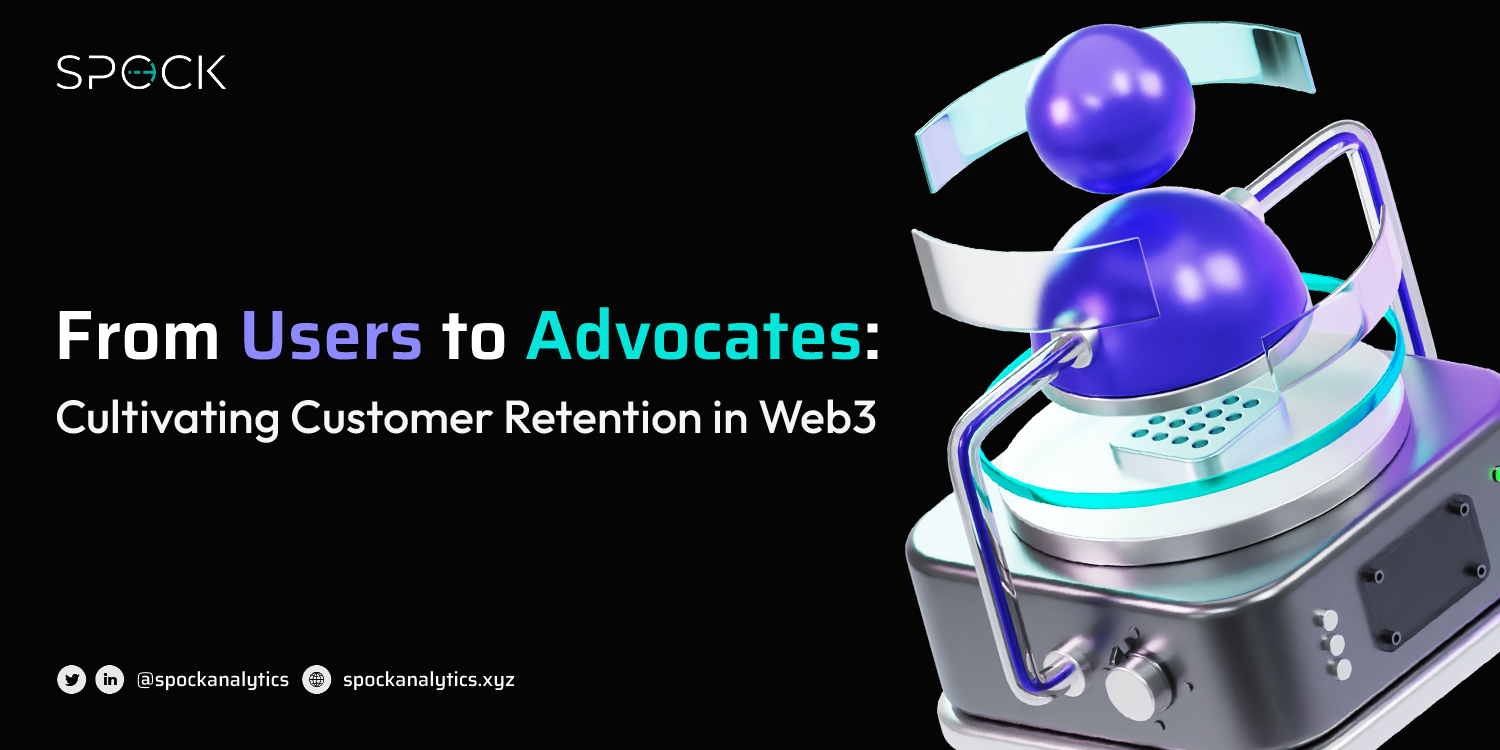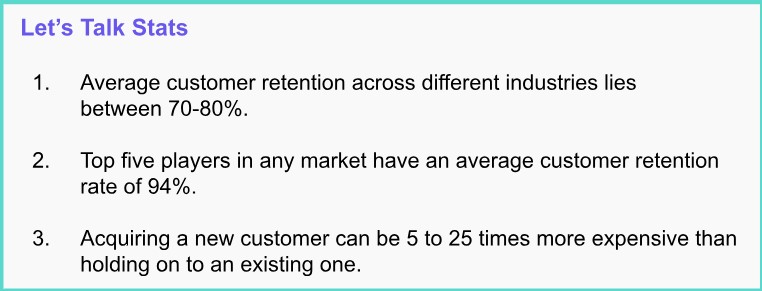
Customer retention; the labyrinth where many product owners find themselves caught during their product journey. But why do they struggle in mastering the art of customer retention? When building a product, it seems pretty obvious for a product owner to think that their ideal user will realize the value of their product on first use and keep using it. However, it is not that straightforward. Think about it. Your average user is surrounded by tens, if not hundreds, of products and tools that all seem to be pitching themselves as the answer to their problem. What makes your product so special that your user would keep coming back to it? What makes it sticky? And what can you do to turn your customers from mere users to advocates for your product? Keep reading to find out. Before we dive into the customer retention specifics, let’s understand the web3 landscape and how it affects the user journey from acquisition to retention. In the web3 space, capturing and maintaining user attention is no longer a mere transactional affair; it's a vital aspect of sustainable success. The struggle to keep users engaged, loyal, and advocating for your Web3 product is a pain point shared by many. Let’s explore some of the problems associated with customer retention in web3: With the increasing number of Web3 projects and decentralized applications (dApps), users are often overwhelmed by the vast amount of information available. This makes it challenging for them to stay engaged and retain an interest in a particular project. Poor user experience (UX) can hinder customer retention in Web3. Complex interfaces, slow transaction times, and unfamiliar processes can frustrate users, leading to abandonment. Seamless UX design and intuitive navigation are crucial to keeping users engaged and satisfied. While Web3 offers enhanced security through decentralized networks and cryptographic protocols, security breaches and scams still pose a significant threat. Users may worry about the safety of their funds or personal information, leading to hesitancy and attrition. Some Web3 platforms may face scalability issues, resulting in slow transaction speeds or high fees during peak usage times. If users experience delays or exorbitant costs, they may lose interest and seek alternatives, impacting customer retention.\ Web3 users often have evolving preferences and high expectations. To maintain their interest, it's crucial to stay updated with the latest trends, technologies, and user demands. Failing to adapt and provide new features or improvements may result in customers seeking alternative solutions. Now that we know the common problems associated with retaining customers, let’s explore what customer retention is, unravel the drivers of customer retention, and then address the above-stated problems while keeping the said drivers in mind. Customer retention can be defined as, “Customer retention is a company’s ability to turn first-time customers into repeat buyers and prevent them from switching to a competitor.” It indicates the quality of your product or the service that you are providing and the extent of customer loyalty. Some of the ways to maximize customer retention are to increase the value of your product or service, enhance user experience, and meet customer expectations. A simple formula is used to measure customer retention, Let’s consider an example to understand it better. Let’s say you create a DeFi wallet for the Polkadot ecosystem. After the launch, 1000 people download it and use it on the day of the launch. The next day, only 600 people return. After a week, 200 people come and use your wallet. And after 1 month, only 100 people are still using your wallet. According to these stats, Now that we are well aware of what customer retention is, and how to measure it, let’s look at the important ingredients that drive customer retention in any web3 product. Successful onboarding plays a crucial role in ensuring that users can easily navigate and set up their new accounts, including any necessary configurations or integrations. Guiding users through these initial steps promptly is essential to establish a strong foundation for retention. Activation plays a vital role in the Web3 landscape by delivering immediate value to new users. By helping them achieve early successes and experience the tangible benefits of the product, a sense of momentum is ignited. This momentum becomes a driving force, fueling motivation and enticing users to come back for more. With each return, users embark on a journey of exploration, eager to uncover the vast potential that Web3 has to offer. Onboarding and activation are important. However, true user retention in the Web3 realm goes beyond these two things. It involves creating usage habits and triggers that prompt users to revisit the product for subsequent tasks. Understanding the natural frequency of usage within the Web3 application and combining it with user habits specific to the product can inform effective onboarding and activation strategies. Simplify the process of creating a Web3 wallet and connecting it to your platform. Provide step-by-step tutorials and intuitive interfaces, leveraging user-friendly Web3 wallets like MetaMask or Trust Wallet. For example, Compound Finance offers a user-friendly onboarding process that guides users through connecting their wallets and interacting with decentralized lending and borrowing protocols. Leverage Web3 technology to offer personalized experiences based on user preferences and behaviors. For instance, NFT marketplaces like OpenSea allow users to create custom collections, curate their galleries, and showcase their unique digital assets. This level of personalization encourages users to engage with the platform and increases their likelihood of staying loyal. Integrate gamified features into your Web3 product to drive user engagement. Decentraland, a virtual reality platform built on the Ethereum blockchain, incorporates gamification elements by allowing users to create and trade virtual assets, participate in events, and earn rewards. These gamified experiences create a sense of fun and accomplishment, keeping users excited and committed. Foster a vibrant community around your Web3 product. Establish dedicated forums or Discord channels where users can connect, share insights, and collaborate. Decentralized autonomous organizations (DAOs) like Aavegotchi involve the community in decision-making through governance mechanisms, enabling users to actively participate in shaping the future of the project. Building a strong community fosters a sense of belonging and encourages users to stay involved. Leverage the principles of decentralization to empower users with ownership and governance rights. For example, Uniswap, a decentralized exchange protocol, allows users to participate in liquidity provision and governance through holding UNI tokens. Giving users a stake in the platform encourages them to stay invested and actively contribute to its success. Keep users informed about platform updates, new features, and upcoming events through regular communication channels. Platforms like Yearn Finance provide newsletters, blog posts, and social media updates to keep their community engaged and informed. Staying connected with users ensures they are aware of the platform's progress and fosters a sense of involvement. Offer responsive customer support for Web3-related queries and issues. Utilize communication channels like Telegram or Discord to provide timely assistance and address user concerns. Projects like Chainlink maintain active developer communities and support forums where users can receive help with integrating their Oracle solutions. Prompt and reliable customer support builds trust and strengthens the user relationship. Embrace the iterative nature of Web3 by constantly improving your product based on user feedback and market demands. Platforms like Gitcoin leverage decentralized funding mechanisms to incentivize developers and community members to contribute to the platform's development. By actively listening to user feedback and implementing enhancements, you demonstrate a commitment to delivering an evolving and valuable Web3 experience. By implementing these Web3-specific strategies, you can cultivate customer retention and create a loyal user base within the dynamic and decentralized Web3 ecosystem. Did you know? Data and analytics play a crucial role in optimizing customer retention strategies. By harnessing the power of data insights, businesses can personalize user experiences, predict user needs and churn, and make data-driven decisions to continually improve their Web3 products. Web3 platforms have access to a wealth of user data that can be utilized to deliver personalized experiences. By analyzing user behavior, preferences, and interactions, businesses can understand their users better and tailor the product to meet individual needs. Predictive analytics empowers Web3 businesses to anticipate user needs and identify potential churn risks. By analyzing historical data patterns and user behavior, businesses can build models that predict user actions and preferences. This enables proactive intervention to address issues and offer personalized recommendations or incentives to retain users. Tools like Spock Analytics can give valuable user journey insights at each touchpoint in your dApp and identify areas of high user drop-off. This can help you take corrective measures to retain your existing customers. A/B Testing and Data-Driven Decision Making: A/B testing is a powerful technique in the Web3 realm, allowing businesses to experiment with different features, designs, or incentives to optimize customer retention. By splitting users into control and test groups and measuring their responses, businesses can gather actionable insights to inform iterative improvements. Data-driven decision-making ensures that changes are based on empirical evidence rather than assumptions. Web3's underlying blockchain technology provides a rich source of data that can be leveraged for retention strategies. By analyzing on-chain transactions, smart contract interactions, and token movements, businesses can gain deeper insights into user behaviors, network effects, and token economics. This allows for the identification of key retention drivers and the development of strategies to enhance user engagement and loyalty. In conclusion, customer retention is a fundamental pillar for sustainable growth in the Web3 industry. While acquiring new users is important, it is equally crucial to focus on retaining existing users and cultivating long-term relationships. Furthermore, by implementing effective strategies and leveraging data insights, businesses can cultivate long-term relationships with their users, effectively converting them from mere users to advocates. Hence, by prioritizing customer retention, Web3 projects can thrive in a competitive landscape, build a loyal user base, and shape the future of decentralized technologies.Understanding the Web3 Landscape
Customer Retention Problems
Information Overload
User Experience Friction
Security Concerns
Limited Scalability and Performance
Evolving User Preferences
What is Customer Retention?
How to Measure Customer Retention?


Customer Retention Drivers
Successful Onboarding
Activation
Habit

Strategies for Cultivating Customer Retention in Web3
Seamless Onboarding Experience
Personalization and Customization
Gamification Techniques
Community Building and Engagement
Empowering Users through Ownership and Governance
Regular Communication and Updates
Exceptional Customer Support
Continuous Iteration and Improvement
Retention can also help you find the Product-Market Fit for your product through a technique called Cohort Analysis or Retention Analysis. It involves grouping users who share a common characteristic and studying their patterns and behaviors within a specific time frame to identify patterns, trends, and potential areas for improvement for your Web3 product.
Leveraging Data and Analytics in Web3 Retention Strategies
Utilizing Data Insights for Personalization and Customization
Predictive Analytics for Anticipating User Needs and Churn
Iterative Improvements
Blockchain Analytics for Deeper Insights
Conclusion
References
Signup for The Vulcan Voice newsletter now and stay ahead of the curve!
Signup for The Vulcan Voice newsletter now and stay ahead of the curve!